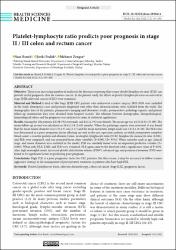| dc.description.abstract | Objective: There is an increasing number of studies in the literature reporting that serum platelet/lymphocyte ratio (PLR) can provide useful prognostic data for various cancers. In the present study, the effects of platelet-lymphocyte ratio on survival in stage II/III colorectal cancers (CRC) were examined. Material and Method:A total of 106 Stage II/III CRC patients who underwent curative surgery 2015-2020 were included in the study. Emergency cases and patients diagnosed with other than adenocarcinoma were excluded from the study. The demographic data of the patients, preoperative imaging and laboratory results, postoperative pathology reports, and patient follow-up examination data were obtained from hospital records. The relations between demographic, histopathological, hematological values and the prognosis was analyzed in terms of statistical significance. Results:Among the 106 patients, 62 (58.5%) were male and 44 (41.5%) were female. The mean age was 64.3±12.01 (23-89). The mean follow-up period was calculated as 24.6±15.8 (2-63) months. When the pathology reports were reviewed, it was found that the mean tumor diameter was 5.3±2.33 cm (2-17) and the mean metastatic lymph node was 1.8±2.4 (0-10). The PLR ratio was determined as a poor prognostic factor affecting survival in the cox regression analysis, in which preoperative complete blood count, c-reactive protein and albumin values, neutrophil-lymphocyte ratio (NLR), lymphocyte-monocyte ratio (LMR), and PLR were compared, and was separated from other variables (P=0.002 CI= 95%). When variables such as age, clinical stage, and tumor diameter were included in the model, PLR was similarly found to be an important predictive variable (P= 0.002). When only NLR, LMR, and PLR were evaluated, PLR again came to the forefront with a significance value of P=0.01. Also, high neutrophil count, increased platelet distribution volume (PDW), advanced age, and perineural invasion (PNI) were found to be significant factors in predicting poor prognosis. Conclusions: High PLR is a poor prognostic factor for CRC patients. For this reason, it may be necessary to follow a more aggressive strategy in the management of postoperative treatment in patients who have high PLR. | en_US |



















